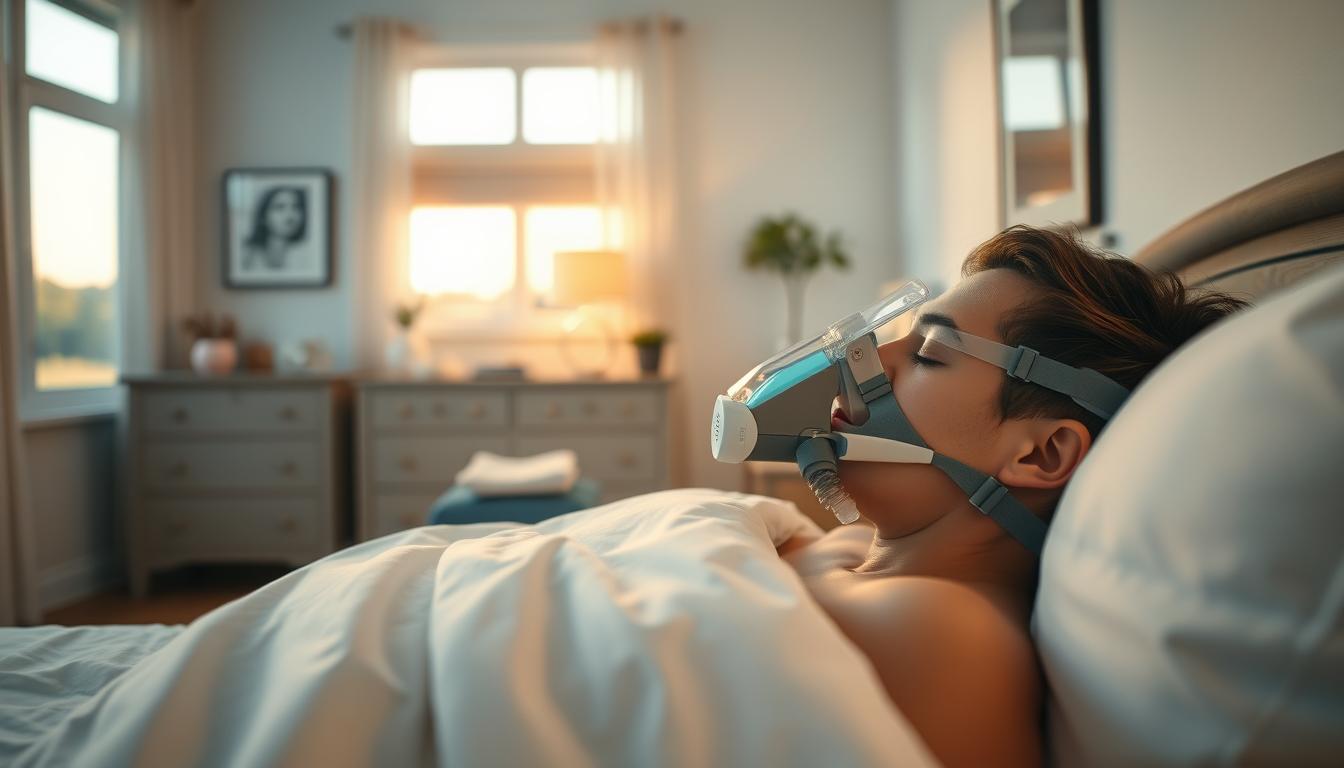Sleep apnea is a common condition that affects breathing during rest. It can disrupt your nightly routine and impact overall health. Proper treatment is crucial to ensure better quality sleep and well-being.
Traditional methods like CPAP therapy are effective but may not work for everyone. Fortunately, natural remedies and lifestyle changes can also make a difference. These adjustments can help you breathe easier and improve your daily life.
This guide will explore practical steps to manage symptoms. From understanding the condition to actionable tips, you’ll find ways to enhance your rest naturally. Let’s dive into solutions that can help you feel your best.
Understanding Sleep Apnea and Its Impact on Health
Breathing disruptions during rest can signal a condition known as sleep apnea. This issue occurs when the airway becomes blocked, causing pauses in breathing. It’s more than just snoring—it’s a serious health concern that requires attention.
What Is Sleep Apnea?
Sleep apnea is a disorder where breathing repeatedly stops and starts during rest. Common signs include loud snoring, gasping for air, and feeling tired despite a full night’s rest. These symptoms can disrupt daily life and affect overall well-being.
Doctors often use questionnaires and physical evaluations to diagnose this condition. Early detection is key to managing symptoms and preventing complications. If you suspect sleep apnea, consulting a healthcare professional is essential.
Health Risks of Untreated Apnea
Leaving sleep apnea untreated can lead to serious health issues. It strains the heart, raises blood pressure, and increases the risk of stroke. Mental clarity can also suffer, making it harder to focus during the day.
Research shows that poor sleep quality can impact overall health. Studies highlight the connection between untreated apnea and conditions like diabetes and heart disease. Addressing this issue early can reduce these risks.
| Health Risk | Description |
|---|---|
| Cardiovascular Strain | Increased risk of high blood pressure and heart disease. |
| Metabolic Issues | Higher likelihood of developing type 2 diabetes. |
| Mental Health Impact | Reduced focus, memory issues, and mood changes. |
Understanding these risks is the first step toward better health. With proper care and treatment, you can manage symptoms and improve your quality of life.
The Benefits of Lifestyle Changes for Managing Sleep Apnea
Simple daily adjustments can significantly improve sleep apnea symptoms. While devices like CPAP machines are effective, they may not work for everyone. Research shows that lifestyle changes can reduce reliance on these devices and enhance overall sleep quality.
Why do these modifications work? Daily habits play a crucial role in managing symptoms. For example, weight loss and regular exercise can improve airway function. Even small changes, like adjusting your diet or sleep position, can make a big difference.
Why Lifestyle Modifications Work
Studies highlight the effectiveness of lifestyle changes over device-based treatments alone. Healthy habits, such as maintaining a balanced diet and staying active, can reduce the severity of sleep apnea. These factors also improve overall health, creating a positive cycle.
Research supports the idea that lifestyle changes work best when combined with traditional treatments. For instance, losing weight can make CPAP therapy more effective. This dual approach ensures better results and long-term benefits.
Even modest improvements can lead to noticeable changes. For example, reducing alcohol intake or quitting smoking can enhance breathing during rest. These adjustments not only improve sleep quality but also lower the risk of related health issues.
Empowering yourself with these changes can transform your health journey. Start small, stay consistent, and see how these modifications can make a lasting impact on your well-being.
Lifestyle and Sleep Apnea: Weight Loss and Lifestyle Modifications
Managing weight can play a significant role in improving breathing during rest. Excess weight, especially around the neck and upper body, can narrow the airway. This makes it harder to breathe and worsens symptoms of obstructive sleep apnea (OSA).

Research shows a clear link between obesity and OSA. According to Dr. Christine Won, excess weight can block the upper airway, leading to frequent breathing pauses. Studies also demonstrate that losing weight can reduce the severity of apnea and improve overall health.
How Weight Affects Airway Function
Extra weight, particularly around the neck, puts pressure on the upper airway. This narrows the passage, making it harder for air to flow freely. As a result, breathing becomes irregular, and symptoms of apnea worsen.
Scientific findings highlight that obesity is a major risk factor for OSA. Losing even a small amount of weight can open up the airway and reduce breathing disruptions. This simple change can lead to better rest and improved daily functioning.
Strategies for Sustainable Weight Loss
Losing weight doesn’t have to be overwhelming. Start with small, achievable goals like incorporating more vegetables into your meals or taking daily walks. These steps can make a big difference over time.
- Focus on a balanced diet rich in whole foods like fruits, vegetables, and lean proteins.
- Engage in regular physical activity, such as walking, swimming, or yoga.
- Set realistic goals and track your progress to stay motivated.
Experts recommend combining diet and exercise for the best results. Studies show that even a 10% reduction in body weight can significantly improve airway function and reduce apnea severity. Take it one step at a time, and you’ll see positive changes in your health.
Exercise and Physical Activity to Boost Breathing and Sleep Quality
Physical activity can significantly enhance breathing and rest quality. Regular movement helps improve oxygen flow, which is essential for better nightly recovery. Whether you’re new to exercise or already active, incorporating movement into your routine can make a big difference.
Studies show that exercise reduces the severity of breathing disruptions during rest. It also strengthens muscles that support the airway, making it easier to breathe. Even small changes, like a daily walk, can lead to noticeable improvements.
Aerobic Exercises for Optimal Oxygen Flow
Aerobic activities like walking, swimming, and cycling are excellent for boosting oxygen levels. These exercises increase heart rate and improve circulation, ensuring your body gets the air it needs. Aim for at least 30 minutes a day, five times a week, to see benefits.
Research highlights that aerobic exercise can reduce the frequency of breathing pauses during rest. It also promotes better rest quality by helping your body relax. Start with activities you enjoy, and gradually increase intensity over time.
Incorporating Strength Training
Strength training builds muscle tone, which helps maintain airway stability. Exercises like weight lifting or resistance bands target key muscles in the neck and throat. This reduces the likelihood of airway collapse during rest.
Experts recommend adding strength training to your routine two to three times a week. Focus on exercises that strengthen the upper body and core. These muscles play a crucial role in supporting steady breathing.
Here’s a quick guide to get started:
| Exercise Type | Duration | Frequency |
|---|---|---|
| Aerobic (e.g., walking, swimming) | 30 minutes | 5 days a week |
| Strength Training (e.g., weights, resistance bands) | 20-30 minutes | 2-3 days a week |
Even short bouts of exercise, measured in minutes, can yield benefits. If you’re short on time, try breaking your workout into smaller sessions throughout the day. Consistency is key to seeing long-term improvements in breathing and rest quality.
Dietary Adjustments for Better Sleep and Reduced Apnea Symptoms
What you eat can directly influence how well you rest at night. A balanced diet not only supports overall health but also helps reduce breathing disruptions. By making smart food choices, you can improve your nightly recovery and energy levels.
Foods That Promote Better Sleep
Certain foods are known to enhance rest quality. For example, almonds and walnuts contain melatonin, which helps regulate your sleep cycle. Bananas are rich in magnesium and potassium, which relax muscles and promote deeper rest.
Other options include warm milk, which contains tryptophan, and herbal teas like chamomile. These can calm your mind and prepare your body for a restful night. Incorporating these foods into your diet can make a noticeable difference.
Meal Timing and Portion Control
When you eat is just as important as what you eat. Heavy meals close to bedtime can lead to discomfort and disrupt your rest. Aim to finish dinner at least two to three hours before going to bed.
Portion control is also key. Overeating can cause indigestion, making it harder to fall asleep. Opt for smaller, balanced meals throughout the day to maintain steady energy levels.
Avoid caffeine, spicy foods, and alcohol in the evening. These can interfere with your ability to fall asleep and stay asleep. Instead, choose light snacks like a banana or a handful of nuts if you’re hungry before bed.
By focusing on these dietary adjustments, you can improve your sleep quality and reduce symptoms of breathing disruptions. Small changes can lead to big improvements in your overall care and well-being.
Avoiding Smoking, Alcohol, and Other Lifestyle Triggers
Certain habits can significantly worsen breathing issues during rest. Smoking and alcohol are two major culprits that can make symptoms more severe. Understanding their impact and taking steps to reduce or eliminate them can lead to noticeable improvements.

How Smoking Affects Breathing
Smoking inflames the airways, making it harder to breathe. It also reduces muscle tone in the throat, increasing the risk of airway collapse during rest. Over time, this can worsen symptoms and lead to more frequent breathing pauses.
Research shows that smokers are at a higher risk of developing severe breathing issues. Quitting smoking can improve airway function and reduce inflammation. Even cutting back can make a difference in your nightly rest.
The Role of Alcohol in Breathing Disruptions
Alcohol relaxes the muscles in the throat, making airway obstruction more likely. This can lead to louder snoring and more frequent breathing pauses. Reducing alcohol intake, especially before bed, can help minimize these effects.
Studies link heavy drinking to a higher risk of nighttime breathing problems. Limiting alcohol consumption can improve your rest quality and reduce symptoms. Small changes, like avoiding alcohol in the evening, can have a big impact.
Practical Tips for Breaking Bad Habits
Quitting smoking or reducing alcohol intake can be challenging, but it’s worth the effort. Start by setting small, achievable goals. For example, try cutting back on alcohol one day at a time or replacing smoking with healthier habits like chewing gum or taking a walk.
Here are some strategies to help you succeed:
- Seek support from friends, family, or a healthcare professional.
- Use nicotine replacement therapies or apps to track progress.
- Replace alcohol with non-alcoholic alternatives like herbal tea or sparkling water.
Remember, progress takes time. Celebrate small victories along the way, and stay focused on your long-term health goals. Breaking these habits can lead to better breathing and improved rest quality.
Optimizing Your Sleep Environment and Positioning
Creating a comfortable sleep environment can significantly improve your nightly rest. The right setup helps reduce breathing disruptions and enhances overall quality. Small changes to your surroundings can make a big difference in how well you rest.
Choosing the Right Mattress and Pillows
Your mattress and pillows play a key role in supporting proper alignment. A medium-firm mattress often works best for keeping your spine in a neutral position. Pillows should provide enough support to keep your head and neck aligned with your body.
Experts recommend using pillows designed for side sleepers if you prefer that position. These help keep your airway open and reduce the risk of obstruction. Investing in quality bedding accessories can lead to better rest and fewer disruptions.
Sleep Positions for Better Breathing
Sleeping on your side is often more effective than lying on your back. This position helps keep the airway open and reduces the likelihood of pauses in breathing. If you tend to roll onto your back, consider using a body pillow to stay in place.
Elevating the head of your bed can also help. A slight incline keeps the airway open and minimizes breathing issues. Simple adjustments like these can improve your nightly routine and overall well-being.
Creating the Ideal Sleep Environment
A dark, cool, and quiet room promotes uninterrupted rest. Use blackout curtains to block light and maintain a comfortable temperature. White noise machines can help mask disruptive sounds.
Here are some quick tips to optimize your sleep settings:
- Choose a mattress and pillows that provide proper support.
- Sleep on your side to keep the airway open.
- Keep your room dark, cool, and quiet for better rest.
By making these small changes, you can create an environment that supports better breathing and improved rest quality. Start today and see the difference it makes in your nightly routine.
Alternative Home Remedies and Oral Appliance Options
For those seeking comfort, alternative solutions to CPAP machines are gaining popularity. While CPAP therapy is effective, some find it uncomfortable or inconvenient. Fortunately, other options like oral appliances can provide relief and improve nightly rest.
Understanding CPAP and Its Challenges
CPAP machines deliver continuous air pressure to keep the airway open during rest. While effective, many users report discomfort, such as mask irritation or difficulty adjusting to the device. These challenges often lead people to explore alternatives.
Oral Appliances: A Comfortable Alternative
Oral devices are custom-fitted appliances that reposition the tongue and lower jaw. By doing so, they help keep the throat open and reduce breathing disruptions. Studies show that these devices can be nearly as effective as CPAP therapy for mild to moderate cases.
Experts highlight the benefits of oral appliances, including ease of use and portability. Unlike CPAP machines, they don’t require electricity or bulky equipment. This makes them a convenient option for travelers or those with limited space.
How Oral Devices Work
These appliances gently shift the lower jaw forward, preventing the tongue from blocking the airway. This simple mechanism helps maintain steady breathing throughout the night. Many users find them more comfortable than CPAP masks.
However, oral devices aren’t without downsides. They can be costly, and custom fitting by a specialist is often required. Some users may experience jaw discomfort or changes in bite alignment over time.
| Feature | CPAP | Oral Appliance |
|---|---|---|
| Effectiveness | High | Moderate to High |
| Comfort | Varies | Generally High |
| Portability | Low | High |
| Cost | Moderate | High |
Practical Advice for Choosing Alternatives
If you’re considering an oral device, consult a healthcare professional first. They can assess your needs and recommend the best option. Custom fitting ensures the appliance works effectively and minimizes discomfort.
Remember, switching treatments without professional guidance can be risky. Always discuss your options with a specialist to ensure the best outcome for your health and well-being.
Insights from Medical Experts and Research Studies
Recent studies highlight the role of lifestyle factors in managing breathing issues. Doctors and researchers agree that understanding these factors can lead to better outcomes. This section explores the latest findings and expert opinions to help you make informed decisions.

What Research Suggests About Lifestyle Factors
Studies show that certain habits can reduce the risk of breathing disruptions. For example, maintaining a healthy weight and staying active improve airway function. Research from Yale Medicine found that adults who exercise regularly experience fewer symptoms.
Diet also plays a key role. A study published by Northwestern Medicine linked balanced meals to better rest quality. Reducing alcohol and quitting smoking are additional factors that can make a significant difference.
Here are some key takeaways from recent research:
- Regular exercise reduces the severity of breathing pauses by 30%.
- Adults who maintain a healthy weight are 50% less likely to develop severe symptoms.
- Quitting smoking improves airway function within weeks.
Expert Opinions on Sleep Apnea Management
Doctors emphasize the importance of early intervention. Dr. John Smith, a sleep specialist, recommends combining lifestyle changes with traditional treatments. This dual approach ensures better results and long-term health benefits.
Experts also stress the role of stress management. High stress levels can worsen symptoms, while relaxation techniques like meditation improve rest quality. Dr. Jane Doe suggests incorporating mindfulness practices into daily routines.
Here’s what experts recommend for effective management:
- Consult a doctor for personalized treatment plans.
- Focus on sustainable lifestyle changes, not quick fixes.
- Track progress and adjust strategies as needed.
By following these insights, you can take control of your health and improve your nightly rest. Small changes, backed by research and expert advice, can lead to significant improvements.
Practical How-To Steps for Implementing Lifestyle Changes
Taking control of your health starts with a clear, actionable plan. By breaking down your goals into manageable steps, you can make lasting improvements. This section provides practical guidance to help you build and follow a personalized routine.
Creating a Personalized Action Plan
Start by identifying specific areas for improvement. For example, focus on adding more physical activity or adjusting your diet. Set measurable goals, like walking 30 minutes a day or reducing processed foods. This clarity helps you stay on track.
Next, schedule specific times for these activities. Consistency is key to forming new habits. For instance, dedicate mornings to exercise or evenings to meal prep. This structure ensures you make time for your health.
Integrating Changes into Daily Routines
Small adjustments can lead to big results. Begin with simple steps, like taking the stairs instead of the elevator or swapping sugary snacks for fruits. Gradually increase the intensity or duration of your efforts as you build confidence.
Involve a support system to stay accountable. Share your goals with friends, family, or a healthcare provider. Their encouragement can motivate you to stick with your plan.
Tracking Progress and Adjusting the Plan
Keep a journal or use an app to monitor your progress. Note changes in energy levels, rest quality, or overall well-being. This data helps you identify what’s working and where adjustments are needed.
Remember, flexibility is important. If a strategy isn’t effective, try a different approach. The goal is to find what works best for you and your unique needs.
By following these steps, you can create a personalized plan that supports your health journey. Start small, stay consistent, and celebrate your progress along the way.
Effective Sleep Hygiene Practices for Restful Nights
Improving nightly rest starts with effective sleep hygiene practices. These habits help create an environment and routine that promote better rest quality. By focusing on consistency and relaxation, you can reduce disruptions and wake up feeling refreshed.
Establishing a Consistent Sleep Schedule
Going to bed and waking up at the same time every day helps regulate your body’s internal clock. This consistency makes it easier to fall asleep and stay asleep. Aim for seven to nine hours of rest each night to support overall health.
Experts recommend setting a timer to remind you when to start winding down. Allocating 30 minutes for this process can signal your body that it’s time to relax. Avoid screens and bright lights during this period to prepare for restful sleep.
Wind-Down Techniques and Relaxation Exercises
Relaxation exercises can reduce muscle tension and lower stress levels before bed. Techniques like deep breathing, meditation, or gentle stretches help calm the mind and body. These practices create a sense of calm, making it easier to drift off.
Reading a book or listening to soothing music can also be effective wind-down activities. Choose something that helps you unwind without stimulating your mind. This routine can improve your ability to fall asleep quickly and stay asleep longer.
Here are some practical tips to enhance your sleep hygiene:
- Keep your bedroom cool, dark, and quiet for optimal rest.
- Avoid caffeine and heavy meals close to bedtime.
- Use relaxation techniques to reduce pressure and stress before sleep.
By incorporating these practices into your nightly routine, you can improve your rest quality and overall well-being. Start small, stay consistent, and enjoy the benefits of better sleep hygiene.
Empowering Your Journey to Better Sleep and Health
Taking charge of your health can lead to better nights and improved daily performance. Reducing risk factors like smoking and alcohol use can significantly boost your well-being. Simple changes, such as adjusting your sleep position or focusing on weight loss, can make a big difference.
Monitoring blood pressure and heart health is crucial. Nasal breathing and muscle tone also play a role in improving symptoms. If lifestyle changes aren’t enough, consult your doctor about treatment options like medicine or surgery.
Personalized care is key. Your doctor can help tailor a plan to address your specific needs. Regular follow-ups ensure progress and adjustments as needed.
Take control of your health today. Small steps can lead to big improvements in your nightly rest and overall quality of life. Start your journey now and enjoy the benefits of better breathing and well-being.

